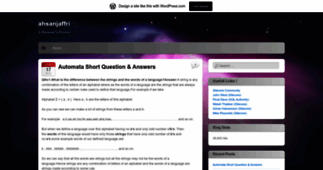Ahsanjaffri
Enter a key term, phrase, name or location to get a selection of only relevant news from all RSS channels.
Enter a domain's or RSS channel's URL to read their news in a convenient way and get a complete analytics on this RSS feed.
Unfortunately Ahsanjaffri has no news yet.
[...] called phonegap.js. In that folder create a file called index.html with the following code: view plaincopy to clipboardprint? <!DOCTYPE HTML> <html> <head> <meta name=” [...]
[...] The second link in the body is responsible for gathering the current device location: view plaincopy to clipboardprint? <a href=”#” class=”btn large” onclick=” [...]
[...] Greek letter Lambda) λ or (Capital Greek letter Lambda) Λ, is called an empty string or null string. The capital lambda will mostly be used to denote the empty string, in further discussion. QNo. [...]
[...] . After you create a new, standard Android project you will update that project to use PhoneGap. In the New Android Project dialog box, type a [...]
[...] workspace can be opened in eclipse. In eclipse choose new project and then choose Android Project. Next select “create project from existing source” and give the project a name as [...]
[...] the downloaded archive to your local hard drive and remember its location. Configure the ADT Plugin for Eclipse Next, you need to set up the ADT (Android Development Tools) plugin for Eclipse. [...]
[...] to download and install Eclipse if you don’t already have it on your machine. Eclipse ADT Plugin You will need to also install the ADT plugin for Eclipse. ADT (Android Development tools) [...]
[...] and it lets you create Android projects from existing source (this is the way we will open our PhoneGap app for android on eclipse). Using ADT you can also debug an android application. As ADT is well [...]
[...] to showing you how to setup this default app for both Android and iPhone. Building the Default PhoneGap App for Android To create a workspace for your PhoneGap app on android, go to the “phonegap- [...]
[...] application in the Android emulator, right-click the project root, and select Run As > Android Application (see Figure 11). Figure 11. Launching the Android application. If you don’t have any [...]
[...] Development tools) is a plugin of eclipse which provide a complete IDE for developing Android application. ADT lets you create new Android projects, and it lets you create Android projects from [...]
[...] started site for Android. Running the application To launch your PhoneGap application in the Android emulator, right-click the project root, and select Run As > Android Application (see Figure 11). [...]
[...] well integrated with android SDK running the app from the IDE directly launches the android emulator. To install ADT click on “install new software” in your Eclipse’s help window and [...]
[...] and learn some of the fundamental development considerations of the platform. Introducing PhoneGap Applications built with PhoneGap are not just like normal mobile web sites. PhoneGap applications are [...]
[...] . Setting up Eclipse The first step in setting up your development environment for PhoneGap applications on Android is to download and install the Eclipse IDE. Android development with PhoneGap [...]
[...] as shown below will be seen: The above should create a complete workspace for your PhoneGap Android app. Setup Your Project in Eclipse Once this is done, this workspace can be opened in eclipse. [...]
[...] called phonegap.js. In that folder create a file called index.html with the following code: view plaincopy to clipboardprint? <!DOCTYPE HTML> <html> <head> <meta name=” [...]
[...] The second link in the body is responsible for gathering the current device location: view plaincopy to clipboardprint? <a href=”#” class=”btn large” onclick=” [...]

